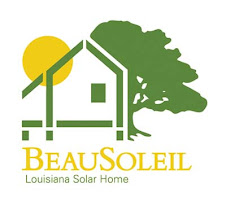The BeauSoleil Louisiana Solar Home design incorporates several aspects of early Cajun cottages. For example, it emphasizes wide exterior porches for social interaction and casual entertaining, as well as movable exterior doors in the “dog-trot” that make access to the outdoors easy. The home also has a large kitchen that is the cultural center of the home. Good conversation and great food, important elements of Louisiana's culture, flow naturally from this functional space.

This structure accommodates Louisiana’s sometimes-challenging climate. Long, hot summers are the norm, so the BeauSoleil Home takes advantage of natural breezes and utilizes several dual-purpose shutters, while collecting its own water and generating more energy than it uses.
And when conditions get tough during hurricane season, as they did in 2005 when Hurricanes Katrina and Rita devastated parts of south Louisiana, the BeauSoleil Home can withstand high winds. The structure can also be elevated to provide housing in areas vulnerable to flooding.
But is this design ready for the commercial market? The answer is a resounding “Yes!” The students and faculty members who make up TEAM BeauSoleil are dedicated to turning this real-world, sustainable living solution into an affordable, working model that can be sold to the public. They used the median income in Louisiana as a guide to design a home that should be affordable when mass-produced. When introduced to the marketplace, it will address the urgent need for self-sufficient residences, especially in the hurricane-prone regions of the Gulf Coast.


No comments:
Post a Comment